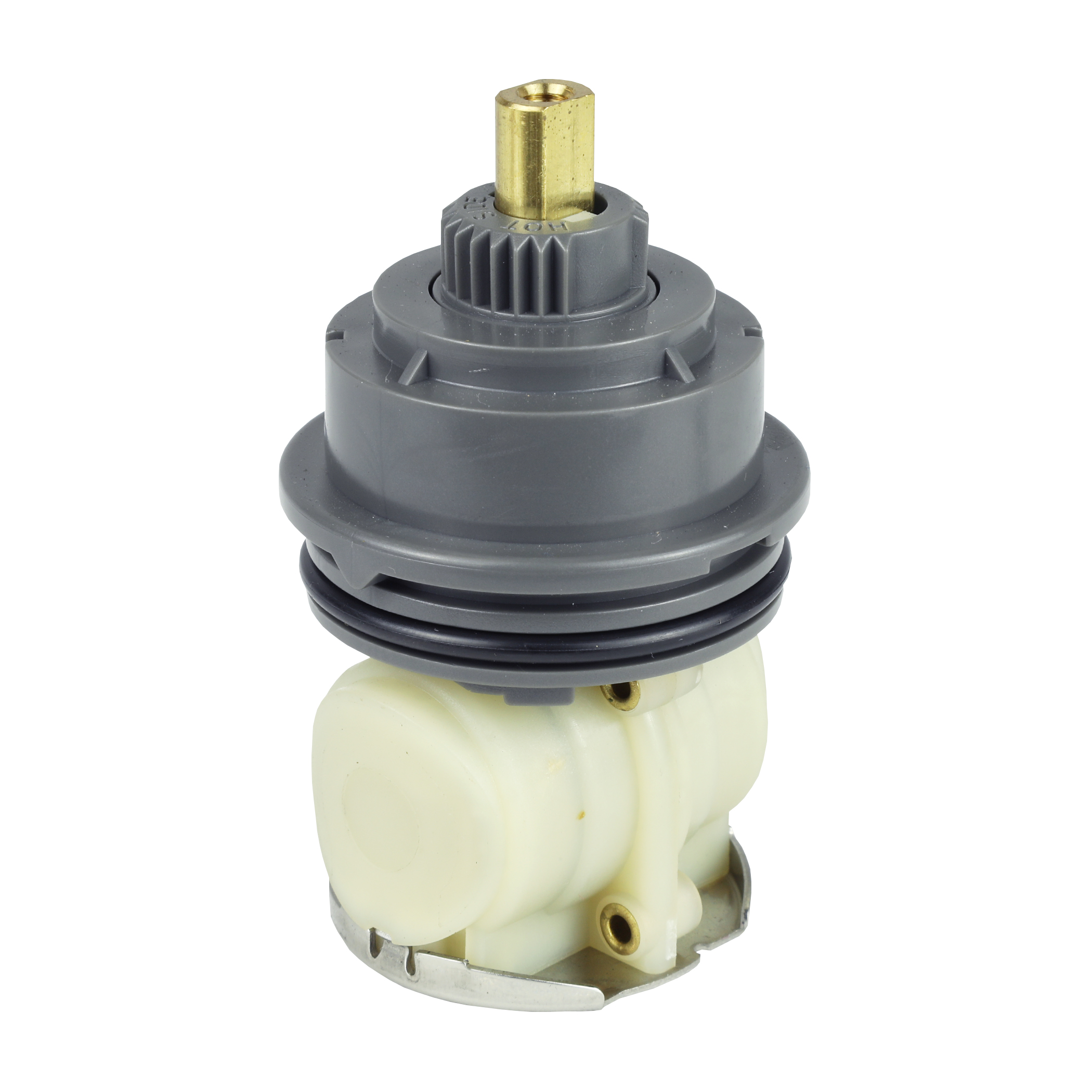What Is It and How Does It Work?
Delta bathroom faucets are renowned for their durability and functionality, with the cartridge being a crucial component. The cartridge is essentially the heart of the faucet, responsible for controlling the flow of water and temperature. Understanding how it works is essential for troubleshooting any issues that may arise.
- What is a Delta Bathroom Faucet Cartridge?: The cartridge in a Delta bathroom faucet is a cylindrical component that sits inside the faucet body. It contains rubber seals and ceramic discs that regulate the flow of water and control the temperature. As you turn the handle, the cartridge moves to adjust the water flow and mix hot and cold water to achieve the desired temperature.
- How Does It Work?: When you turn the faucet handle, it lifts or rotates the cartridge, allowing water to flow through the faucet. The position of the cartridge determines the water temperature and flow rate. As water passes through the cartridge, the ceramic discs inside move to either restrict or allow water flow, while the rubber seals prevent leaks.
- Benefits of a Delta Cartridge: Delta cartridges are known for their reliability and longevity. Their ceramic disc technology ensures smooth operation and minimal wear and tear, resulting in fewer leaks and drips over time. Additionally, Delta offers a wide range of cartridge options to suit different faucet models and user preferences.
- Common Issues: Despite their durability, Delta cartridges can experience issues over time. Common problems include leaks, dripping faucets, difficulty turning the handle, or inconsistent water temperature. These issues may arise due to mineral buildup, worn-out seals, or damaged ceramic discs within the cartridge.
- Maintenance Tips: Regular maintenance is key to prolonging the life of your Delta cartridge. Cleaning the faucet aerator and removing mineral deposits can help prevent clogs and maintain water pressure. Additionally, lubricating the cartridge with silicone grease can ensure smooth operation and prevent leaks. If you encounter any issues, it’s essential to address them promptly to prevent further damage to the cartridge and faucet.

Signs Your Delta Bathroom Faucet Cartridge Needs Replacement
The cartridge in your Delta bathroom faucet is built to last, but like any mechanical component, it may eventually wear out or develop issues. Recognizing the signs that your cartridge needs replacement is essential for maintaining the functionality of your faucet and preventing water damage.
Leaking or Dripping Faucet: One of the most common signs that your Delta cartridge needs replacement is a leaking or dripping faucet. This can occur due to worn-out seals or damaged ceramic discs within the cartridge. If you notice water pooling around the base of the faucet or a constant drip, it’s time to inspect the cartridge.
Difficulty Turning the Handle: If you find it increasingly difficult to turn the faucet handle or notice resistance when adjusting the water flow or temperature, it could indicate a problem with the cartridge. Mineral buildup or worn-out components may impede the movement of the cartridge, requiring replacement to restore smooth operation.
Inconsistent Water Temperature: A malfunctioning cartridge can result in inconsistent water temperature, making it challenging to achieve the desired warmth for showers or washing dishes. If you experience sudden fluctuations in water temperature or find it impossible to balance hot and cold water, the cartridge may be to blame.
Reduced Water Pressure: A faulty cartridge can also lead to reduced water pressure, affecting the overall performance of your faucet. Mineral deposits or debris may accumulate inside the cartridge, restricting water flow and causing a decrease in pressure. Cleaning the cartridge may resolve this issue, but if the problem persists, replacement may be necessary.
Visible Damage: Inspect the cartridge for any visible signs of damage, such as cracks, chips, or warping. Physical damage can compromise the integrity of the cartridge, leading to leaks and other issues. If you notice any damage, it’s best to replace the cartridge to prevent further damage to your faucet and plumbing.
Troubleshooting Tips: Before replacing the cartridge, try troubleshooting common issues such as mineral buildup or debris blocking the water flow. Cleaning the cartridge with vinegar or a commercial cleaner can help remove deposits and restore functionality. If the problem persists, replacement may be the best course of action.
How to Replace a Delta Bathroom Faucet Cartridge
Replacing a Delta bathroom faucet cartridge may seem daunting at first, but with the right tools and instructions, it can be a straightforward DIY project. Follow these step-by-step guidelines to replace your Delta faucet cartridge efficiently and safely:
Gather Your Tools: Before you begin, gather the necessary tools and materials. You’ll typically need an adjustable wrench, screwdriver, plumber’s grease, and a replacement Delta cartridge specific to your faucet model.
Turn Off the Water Supply: Locate the shut-off valves under the sink and turn them clockwise to shut off the water supply to the faucet. Open the faucet handles to drain any remaining water in the lines.
Remove the Handle: Use a screwdriver to remove the screw securing the faucet handle. Once the screw is removed, carefully pull the handle off to expose the cartridge housing.
Unscrew the Cartridge Housing: Depending on your faucet model, the cartridge housing may be held in place with screws or a locking nut. Use the appropriate tool to loosen and remove the housing, exposing the cartridge.
Remove the Old Cartridge: Grasp the top of the cartridge with pliers and gently pull it straight out of the faucet body. If the cartridge is stuck, you may need to use a cartridge removal tool or lubricate it with a plumber’s grease to facilitate removal.
Install the New Cartridge: Apply the plumber’s grease to the O-rings of the new Delta cartridge to ensure a tight seal. Insert the cartridge into the faucet body, making sure it is aligned correctly. Push the cartridge firmly into place until it sits flush with the housing.
Reassemble the Faucet: Replace the cartridge housing and secure it with screws or a locking nut, depending on your faucet model. Slide the faucet handle back onto the cartridge stem and secure it with the screw.
Turn On the Water Supply: Turn the shut-off valves under the sink counterclockwise to restore the water supply to the faucet. Slowly turn on the faucet handles and check for any leaks or irregularities in the water flow.
Test the Faucet: Once the water is flowing smoothly, test the faucet to ensure the hot and cold water are mixing correctly and that there are no leaks around the handle or spout.
Choosing the Right Replacement Cartridge for Your Delta Faucet
When it comes to selecting a replacement cartridge for your Delta faucet, it’s essential to choose the right one to ensure compatibility and optimal performance. Here are some factors to consider when choosing a replacement cartridge:
Faucet Model: Delta offers a wide range of faucet models, each requiring a specific cartridge type. Before purchasing a replacement cartridge, identify the model of your faucet and ensure compatibility with the new cartridge.
Cartridge Type: Delta faucets may use different types of cartridges, including single-handle and double-handle cartridges, as well as pressure-balancing and thermostatic cartridges for shower faucets. Determine the type of cartridge your faucet requires to ensure a proper fit and functionality.
Material and Construction: Delta cartridges are available in various materials, including ceramic, brass, and plastic. Ceramic cartridges are known for their durability and smooth operation, while brass cartridges offer excellent longevity and resistance to corrosion. Consider the material and construction of the replacement cartridge to ensure durability and reliability.
Hot/Cold Water Compatibility: Some Delta cartridges are designed specifically for hot or cold water applications, while others are suitable for both. Ensure that the replacement cartridge you choose is compatible with the intended water temperature and application to avoid issues with water flow and temperature regulation.
OEM vs. Aftermarket Cartridges: While Delta OEM (Original Equipment Manufacturer) cartridges are designed to meet the manufacturer’s specifications, aftermarket cartridges may offer more affordable alternatives. However, be cautious when purchasing aftermarket cartridges, as they may vary in quality and compatibility. It’s generally recommended to opt for OEM cartridges to ensure proper fit and performance.
Warranty and Support: Check the warranty and support options available for the replacement cartridge, especially if you’re purchasing it separately from the faucet. Delta offers warranties on their cartridges, providing peace of mind and protection against defects or malfunctions.
Reviews and Ratings: Before making a purchase, read reviews and ratings from other customers to gauge the reliability and performance of the replacement cartridge. Look for feedback regarding compatibility, ease of installation, and long-term durability to make an informed decision.
Maintenance Tips to Prolong the Life of Your Delta Bathroom Faucet Cartridge
Proper maintenance is essential to prolong the life of your Delta bathroom faucet cartridge and ensure optimal performance. Follow these maintenance tips to keep your faucet in top condition:
Regular Cleaning: Clean your faucet regularly to remove mineral deposits, soap scum, and other debris that can affect the performance of the cartridge. Use a mild soap and water solution or a non-abrasive cleaner to wipe down the faucet surfaces, including the handle, spout, and cartridge housing.
Check for Leaks: Periodically check for leaks around the faucet handle, spout, and base. If you notice any leaks or dripping, address them promptly to prevent water damage and prolong the life of the cartridge. Tighten loose fittings or replace worn-out seals and O-rings as needed.
Avoid Excessive Force: Avoid using excessive force when operating the faucet handle, as this can put unnecessary strain on the cartridge and lead to premature wear and tear. Turn the handle gently and avoid slamming it shut to prolong the life of the cartridge.
Use Caution with Hard Water: If you have hard water, consider installing a water softener or using a faucet filter to reduce mineral buildup and prolong the life of the cartridge. Hard water can cause mineral deposits to accumulate inside the faucet, affecting the cartridge’s performance over time.
Lubricate Moving Parts: Apply the plumber’s grease to the O-rings and moving parts of the cartridge periodically to ensure smooth operation and prevent friction-related damage. This simple maintenance task can help extend the life of the cartridge and prevent leaks.
Schedule Routine Inspections: Schedule routine inspections of your faucet to check for any signs of wear or damage to the cartridge. Look for cracks, chips, or deterioration in the cartridge housing, as well as any irregularities in water flow or temperature. Address any issues promptly to prevent further damage and ensure optimal performance.
Delta Replacement IB-133670 Pressure Balance Cartridge for Tub u0026 Shower Valves
Delta® faucet cartridge – Master Plumber®
FlowRite Pro Shower Cartridge Replacement for Delta Faucets RP19804 13 and 14 Series
Single-Handle Valve Cartridge
Delta® Replacement Tub/Shower Faucet Cartridge at Menards®
Cartridge for Delta 1500/1700 Series Tub and Shower Faucets
Replacement Stem Assembly for Delta Faucet RP25513
Danco Plastic Tub/Shower Valve Cartridge for Delta
Cartridge for Delta 17 Series MultiChoice Tub and Shower Faucets
Related Posts:
- Aqua Plumb Bathroom Faucet
- How To Install Moen Widespread Bathroom Faucet
- Kitchen And Bathroom Faucet Aerators
- Purist Bathroom Faucet
- Shelf Back Bathroom Faucet
- Black Wall Mount Bathroom Faucet
- English Bathroom Faucets
- Chatsworth Bathroom Faucets
- How To Install Moen Bathroom Faucet
- Pfister Ashfield Bathroom Faucet












